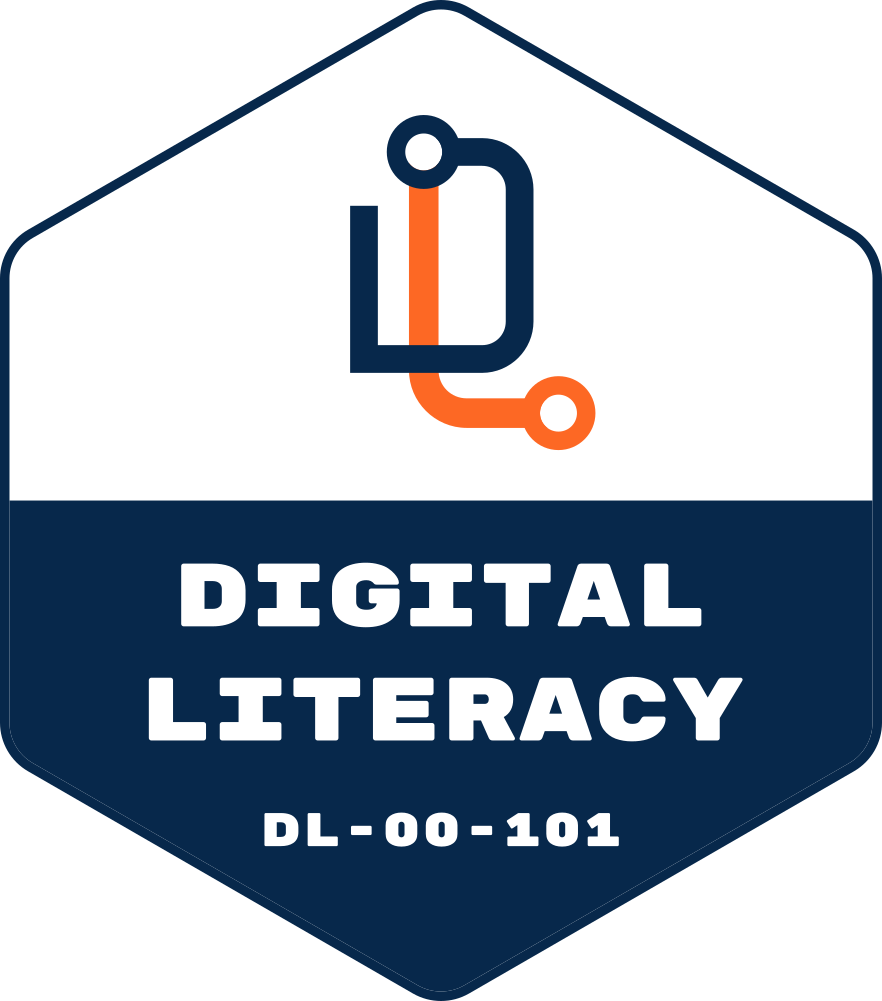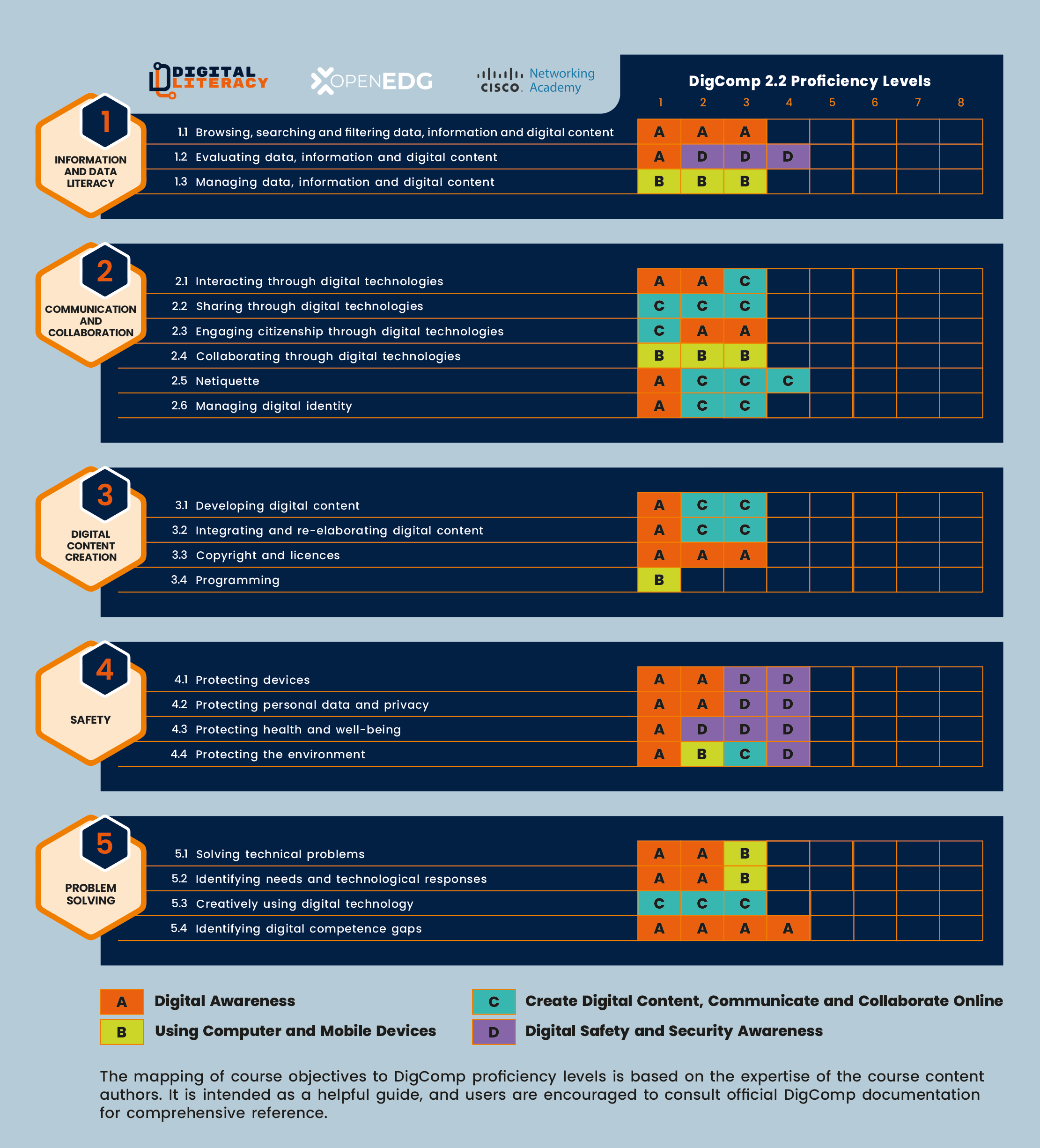Digital Literacy

In today’s fast-paced, tech-driven world, digital proficiency isn’t just useful—it’s essential.
The Digital Literacy Certification Program will help you build the skills you need to use technology with confidence and ease, and earn an official certificate to prove your expertise.
Designed for learners aged 16+, the program is divided into four key topic areas:
- Digital Awareness
- Using Computers and Mobile Devices
- Creating, Communicating, Collaborating
- Safety and Security
Each course covers a different area and is aligned with a milestone exam. By successfully completing all four milestone exams, you will earn the OpenEDG Digital Literacy Certification.
Through the four courses, you’ll gain essential skills in hardware and software fundamentals, digital communication, document management, cloud collaboration, cybersecurity best practices, and responsible technology use.
Whether you want to manage daily tasks more efficiently, navigate digital environments securely, or leverage online resources to gain in-demand skills, this certification provides a strong foundation for mastering any digital tool or technology.
Flexible Certification Pathway and Study Resources
The Digital Literacy learning collection consists of four courses, each packed with videos, reading materials, in-depth step-by-step tutorials, and interactive exercises based on real-life scenarios.
Each course is aligned with a milestone exam, allowing you to earn credentials along the way and progress toward your full Digital Literacy Certificate. By successfully completing all four milestone exams, you will earn the OpenEDG Digital Literacy Certification, validating your foundational digital skills and ability to navigate the modern digital landscape with confidence.
Alternatively, if you already feel confident in your digital skills, you can skip the milestone exams and take the Digital Literacy Exam (DL-00-101) directly. This comprehensive assessment covers the material from all four courses and milestone exams in a single test.
Each course in the Digital Literacy learning collection builds essential skills through videos, easy-to-follow step-by-step tutorials using real software, interactive exercises, problem-solving activities, and environmental tips—alongside more traditional formats like reading materials and quizzes.
Milestone exam details:
- 25 single-select questions
- 40-minute time limit
- Passing score: 70%
DL-00-101: Exam Information
SPECIFICATIONS ITEM
DESCRIPTION
Exam Name
DL-00-101 – Digital Literacy
Exam Code & Current Exam Versions
DL-00-101 (Status: Active)
Prerequisites
None
Validity
Lifetime
Exam Duration
Exam: 60 minutes, NDA/Tutorial: 5 minutes
Number of Questions
60
Format
Single-select questions
Passing Score
70%
Languages
English
Cost
USD 49 (Exam: Single-Shot) - Purchase Exam Voucher
Delivery Channel
OpenEDG Testing Service – TestNow™
Testing Policies
Click here to view Testing Policies
Exam Syllabus
Click here to view Exam Syllabus
Courses Aligned
Digital Literacy (Cisco Networking Academy)
Digital Literacy Exam Syllabus
DL-00-101 Exam Syllabus
Status: LIVE & ACTIVE

DL_1_1 Evaluate digital technologies for managing everyday tasks.
- Identify the uses of digital technologies in daily tasks.
- Analyze the strengths and weaknesses of digital technologies.
- Demonstrate effective tools for personal scheduling, communication and productivity.
- Identify the functions and roles of internal and external hardware components, including storage devices, memory modules, printers, scanners and displays, in the context of installing, diagnosing and troubleshooting hardware issues.
DL_1_2 Identify essential hardware and digital content sources.
- Demonstrate secure connections and reliable search methods.
- Evaluate platform usability, content credibility and security.
- Apply strategies for responsible consumption and sharing.
- Demonstrate efficient content organization.
- Describe common types of digital content (e.g., audio, video, image, text, applications) and identify typical file formats associated with each.
- Compare platforms and methods for accessing, organizing, and consuming digital content across devices.
DL_1_3 Explain the evolution of digital technologies and their impact on society, addressing milestones, ethical considerations, and strategies for responsible and positive digital engagement.
- Identify key milestones in the evolution of digital technologies and their societal impact.
- Analyze ethical considerations arising from the use of digital technologies.
- Propose guidelines for the responsible use of digital tools and platforms.
- Demonstrate how to build and maintain a positive digital presence by managing online profiles.
- Explain strategies for protecting digital identity and safeguarding reputation online.
- Understand what intellectual property is in the context of digital content, explain differences between Public Domain, Fair Use, Creative Commons, and copyright.
- Identify and apply ethical and legal guidelines for using and sharing copyrighted digital content, information, applications, software and other digital resources responsibly.
DL_1_4 Identify key skills for digital proficiency, demonstrate the use of tools to enhance these skills, analyze methods for improvement, and develop a plan for continuous growth.
- Identify key skills required for digital proficiency.
- Demonstrate the use of tools to enhance digital skills.
- Analyze methods for improving digital proficiency.
- Develop a plan for continuous growth in digital proficiency.
DL_2_1 Develop computing skills to enhance functionality and collaboration.
- Explore and understand core computing concepts.
- Perform essential computing operations.
- Analyze system components and evaluate the impact of software on performance.
- Utilize cloud storage to improve usability and foster collaboration.
- Explain procedures for handling, installation, configuration, and troubleshooting of internal computer hardware in scenarios such as system upgrades and custom PC builds.
DL_2_2 Develop software proficiency to effectively manage and evaluate digital tools.
- Identify different types and functions of software.
- Install and configure software programs.
- Distinguish between system software and application software.
- Evaluate software solutions for task-specific usability.
- Evaluate and apply software solutions and operating system tools for task-specific usability, and cross-platform troubleshooting.
DL_2_3 Develop networking proficiency to build, analyze, and secure networks effectively.
- Describe key networking terminology, components, and protocols used in wired and wireless networks.
- Set up, configure, and secure wired and wireless networks using appropriate protocols and security settings.
- Compare wireless security protocols and authentication methods to evaluate strengths, weaknesses, and appropriate use cases.
- Evaluate network security features and identify potential vulnerabilities in wired and wireless setups.
- Identify and troubleshoot common wired and wireless network issues using systematic diagnostic methods and appropriate networking tools, such as cable testers, Wi-Fi analyzers, and configuration utilities.
- Connect, configure, and support mobile devices by managing ports, accessories, and wireless connectivity for data sharing and application access.
- Demonstrate and implement methods for mobile device synchronization with other systems, including laptops and desktops, for data continuity and access.
DL_2_4 Explore key computing innovations and their impact on society and industries.
- Understand the significance of key computing innovations.
- Demonstrate practical applications of computing innovations.
- Analyze the impact of computing innovations on various industries.
- Evaluate potential future developments and societal effects of computing innovations.
DL_3_1 Understand and apply document creation skills to produce accessible and well-organized files across various formats.
- Explore and use basic word processing features.
- Create formatted documents for clarity and professionalism.
- Analyze file types and backup methods for creating and managing documents across various formats.
- Ensure documents are accessible for all users.
DL_3_2 Understand and apply concepts of digital collaboration and communication to enhance interaction and efficiency.
- Use appropriate tools for digital collaboration and communication.
- Analyze digital etiquette for effective communication.
- Evaluate current collaboration practices and propose improvements.
DL_3_3 Explore digital tools for hybrid working to enhance collaboration, productivity, and community building.
- Identify the role of digital tools in collaboration and social interaction
- Demonstrate effective use of digital tools in team settings
- Analyze digital etiquette for hybrid working environments
- Evaluate current practices to propose improvements in productivity, collaboration, and community building
DL_4_1 Explore digital security threats and strategies to recognize, respond to, and mitigate them effectively.
- Identify the characteristics of common digital security threats.
- Demonstrate strategies for recognizing and responding to digital security threats.
- Analyze the impacts of digital security threats on individuals and organizations.
- Evaluate the effectiveness of security measures to mitigate digital threats.
DL_4_2 Explore security best practices to protect devices and digital content effectively.
- Identify and apply strategies to secure devices and protect digital content, including mobile technologies, using physical and logical security measures.
- Implement and maintain security best practices by applying appropriate security policies, procedures, and relevant system and software updates.
- Analyze the risks of unsecured devices and digital content.
- Evaluate the effectiveness of security measures to propose improvements.
- Recognize different types of passwords and describe the rules and best practices for creating strong, secure passwords, including complexity requirements, when and how to reset them, multi-factor authentication, and secure management techniques.
DL_4_3 Identify and explore best practices for maintaining online privacy and minimizing environmental impact.
- Safeguard personal data by exploring and implementing privacy best practices.
- Analyze risks associated with online activities and their impact on personal privacy.
- Evaluate current privacy practices to propose improvements for data protection.
- Assess the environmental impact of data storage and propose practices to reduce digital footprints.
DL_4_4 Identify and address health risks of prolonged digital technology use to promote well-being and balanced habits.
- Identify health risks associated with prolonged use of digital technology.
- Implement strategies to improve physical and mental well-being.
- Analyze the effects of excessive technology use on mental and physical health.
- Propose a balanced plan for healthier digital habits.
Aligned with Exam DL-00-101
DigComp 2.2 Proficiency Levels mapped with Digital Literacy Courses
DigComp 2.2 Proficiency Levels
1. INFORMATION AND DATA LITERACY
1.1 Browsing, searching and filtering data, information and digital content
1.2 Evaluating data, information and digital content
1.3 Managing data, information and digital content
1
A
A
B
2
A
D
B
3
A
D
B
4
D
2. COMMUNICATION AND COLLABORATION
2.1 Interacting through digital technologies
2.2 Sharing through digital technologies
2.3 Engaging citizenship through digital technologies
2.4 Collaborating through digital technologies
2.5 Netiquette
2.6 Managing digital identity
1
A
C
C
B
A
A
2
A
C
A
B
C
C
3
C
C
A
B
C
C
4
C
3. DIGITAL CONTENT CREATION
3.1 Developing digital content
3.2 Integrating and re-elaborating digital content
3.3 Copyright and licences
3.4 Programming
1
A
A
A
B
2
C
C
A
3
C
C
A
4
4. SAFETY
4.1 Protecting digital content
4.2 Protecting personal data and privacy
4.3 Protecting health and well-being
4.4 Protecting the environment
1
A
A
A
A
2
A
A
D
B
3
D
D
D
C
4
D
D
D
D
5. PROBLEM SOLVING
5.1 Solving technical problems
5.2 Identifying needs and technological responses
5.3 Creatively using digital technology
5.4 Identyfing digital competence gaps
1
A
A
C
A
2
A
A
C
A
3
B
B
C
A
4
A
A
Digital AwarenessB
Using Computer and Mobile DevicesC
Create Digital Content, Comunicate and Collaborate OnlineD
Digital Safety and Security AwarenessThe mapping of course objectives to DigComp proficiency levels is based on the expertise of the course content authors. It is intended as a helpful guide, and users are encouraged to consult official DigComp documentation for comprehensive reference.




